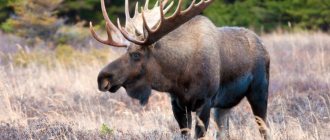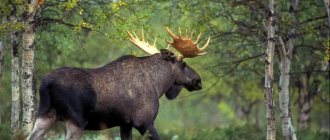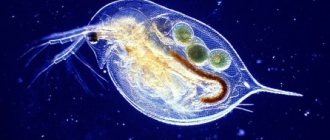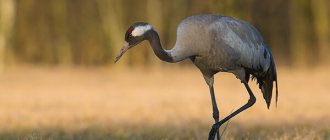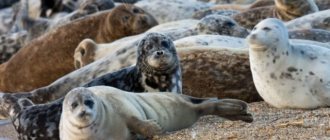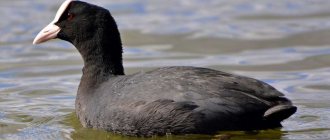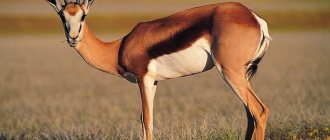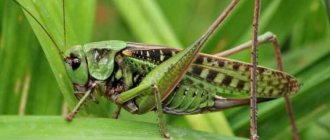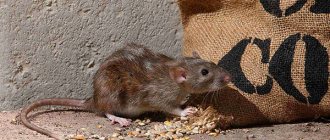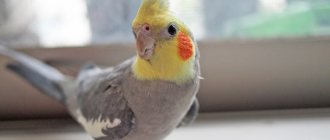- Wild animals
- >>
- Mammals
Elk , or Alces alces, is a giant among artiodactyl mammals. It was called Sokhaty because of its bulky horns, reminiscent of a plow in shape. The beast is widely distributed throughout the northern forests of Europe, Asia and the North American continent. It differs from other representatives of the deer family in its long legs, short but massive body, high withers, and large long head.
Kamchatka moose
The largest animals from the deer family live on the Kamchatka Peninsula. The average weight of an adult moose reaches 800 kilograms for males, and females weigh about 400 kilograms.
The animals manage to reach such gigantic sizes thanks to the varied and plentiful amount of food that is available even in winter. Some scientists are of the opinion that these animals grow to gigantic sizes thanks to the umbrella plant, which grows specifically in Kamchatka and provokes the production of growth hormone in animals.
An interesting fact is that moose were brought to Kamchatka only in the 80s of the last century as an experiment. They were brought from the Anadyr basin.
A genetic connection has been established between animals living in Kamchatka and Alaska, but our moose are still the leaders in size. The average weight of a North American moose does not exceed 600 kilograms.
Moose living in Kamchatka also live in the Middle and Upper Kolyma, Anadyr and Indigirka, which is why they are also called the Chukchi or Kolyma species.
Enemies
In the wild, elk have few natural enemies. Its size and strength scare away small predators. Only bears (grizzly or brown) and wolves can attack them.
Bears prefer to hunt in northern regions where there is a lot of snow. They come out of their dens and guard the elk, or try to drive the prey into dense thickets that prevent the elk from fighting off with its hooves. Bears hunt persistently, sometimes they chase elk through the snow crust for many kilometers. More often, a bear attacks a pregnant moose cow or young moose calves. Females protecting their young behave fiercely. An elk, fighting off a bear, can injure or kill it with blows from its hooves.
Wolves prefer different hunting tactics. They choose areas where there is little snow, because in deep snow they cannot catch even young moose calves. It is difficult for a wolf to attack an adult, since it can easily deal with it with its hooves. Alone, the wolf rarely attacks. Wolves attack elk in a pack, coming from behind.
Smaller predators attack wounded and exhausted animals or young moose calves. The main enemy of the moose is man. Since ancient times, people have hunted moose for meat and hides.
European look
These are medium-sized animals. The average weight of elk in the middle zone does not exceed 500 kilograms (males).
The animal lives in the Urals and Western Siberia, in Altai. Also on the territory of the republics of the former USSR: in Ukraine, Belarus, and the Baltic states. In Europe it is found in the Czech Republic, Poland and Scandinavia.
At the same time, artiodactyls living in Western Siberia are much larger than their relatives living in the European part.
For example, the body length of the European species of moose does not exceed 250 centimeters, and individuals living in Siberia reach 270 centimeters or more with a maximum height at the withers of 185 centimeters.
Accordingly, the average weight of an elk in Russia reaches 480-500 kilograms, while animals living in Europe barely reach 400 kilograms.
Economic importance
Elk at a watering hole
Elk is considered a valuable animal. People use its meat for food, and the skin is used for leather. There are two farms in the Russian Federation where this animal is bred. Moose milk is used for medicinal purposes and tastes similar to cow milk.
Interesting fact : people tried to tame moose and turn them into riding animals, but this turned out to be economically unprofitable.
Ussuri species
This is a small animal, perhaps the smallest among all moose species. The legs of artiodactyls are much shorter than those of other species, the body is thin, with a light color. The muzzle is large. The weight of an adult moose does not exceed 200 kilograms. The height at the withers of males is from 170 to 195 centimeters.
This species' antlers do not form a spade and are more like the antlers of a deer. The outer diameter of the horns can reach 100 centimeters and weigh up to 8 kilograms.
Ussuri moose, living in Primorye, can be somewhat larger, weighing about 400 kilograms. The average weight of an elk living in Manchuria does not exceed 300 kilograms. The most typical representatives of the species include animals living in Sikhote-Alin.
Interesting Facts
The behavior of artiodactyl giants is still under study. And although moose lead a fairly understandable lifestyle that is open to research, some aspects of their existence remain in question.
Many interesting facts are associated with unusual representatives of deer:
- Representatives of the species have very poor eyesight. A moose can pass by a person at a distance of several meters. But poor eyesight is more than compensated by sensitive hearing and sense of smell.
- The Swedes process moose droppings and make paper from it. This became possible due to the fact that the litter contains a large amount of cellulose.
- Elk has been a valuable game animal since time immemorial. At the beginning of the 19th century, in some European countries, representatives of the species were on the verge of extinction, and only strict bans on shooting and conservation measures helped preserve the population.
- Russian and Scandinavian farmers tried to domesticate moose, but the animals turned out to be very difficult to maintain, so the idea had to be abandoned. In addition, moose become uncontrollable during the rut, and it is extremely difficult to cope with a giant.
- The speed of the moose is 56 km/h.
- Moose milk is similar in taste to cow's milk. It contains less sugar and more fat. Moose milk is used in dietary and therapeutic nutrition.
- Surprisingly, moose monuments stand in several cities at once. There are sculptures depicting animals in Moscow, Vyborg and Monchegorsk.
- During the Civil War, elk were used as riding animals. Special detachments were formed to quickly advance through swampy and forested areas. There were rumors among the Scandinavians that the Russians had made a deal with the “spirits of the forest.”
- Small moose calves, like foals, can become attached to humans in the first days of their lives. There are known cases of newborn moose calves rescued by humans recognizing their “breadwinner” when meeting in the forest, several years after separation.
- If during pregnancy the female does not have enough food, then the fetus begins to dissolve and nourish the mother’s body.
- Long-legged moose cannot reach the grass, and in order to pick a juicy bunch they are forced to spread their legs wide apart. The kids cannot maintain their balance, and in order to reach the grass, they kneel down, while comically sticking out their loins.
- In order for the moose cow to let the milkmaid come to her, she coats her hands and robe with amniotic fluid, immediately after the calf is born.
Diet
In the forest-tundra, animals prefer aspen and birch forests; in the steppes they can move away from forests. For a quality life, moose need swamps and lakes, where they can escape the heat and nibble on aquatic vegetation.
In winter, artiodactyls need coniferous and mixed plantings where there is dense undergrowth.
Animals do not have a specific time for feeding; if it is hot, they postpone dinner until night, and in severe frosts they hide in the snow.
Artiodactyls prefer tree and shrub vegetation and consume herbs. They are very fond of aquatic and semi-aquatic grasses, horsetails, marigolds, water lilies, and watchwort. Sorrel and fireweed are used in cutting areas.
At the end of the summer season, you won’t mind treating yourself to mushrooms, including even fly agarics. They eat branches and fruits of lingonberries and blueberries. In winter, twigs of pine and willow, rowan, birch and fir are used. In the spring, when it is very difficult to find food, they eat tree bark.
Large males can eat about 35 kilograms of vegetation per day, and in winter - up to 15 kilograms of branches.
Almost all representatives of the species visit salt licks. If there are none nearby, they can go out onto the highway and lick salt from the road.
They are dying out, but not yet at an alarming rate.
According to the IUCN, moose are a species of Least Concern. It is "very widespread and extremely abundant, despite being hunted quite intensively in some parts of its range." Although in some regions its population is still declining.
In addition to poachers and hunters, moose are threatened by habitat loss. The climate crisis is also having a negative impact, as rising temperatures lead to overheating, illness and tick infestations. When it gets too hot, moose lose weight, don't breed as often, and become more vulnerable to disease.
Reproduction
Elks rarely create harems for themselves, as a rule. However, if there is enough food, then one moose may have several females.
When a male's excitement reaches its maximum, he can destroy everything in his path. As soon as the elk notices a female, he chases her, driving away young males along the way. If there are more males than females nearby, the males can engage in terrible fights.
The female can give birth to offspring in the 2nd or 3rd year of birth. Pregnancy does not exceed 240 days. Children appear in early June. If there are two babies in the litter, then most likely one of them will die. Confidence in the legs appears a week after birth. At birth, depending on the species, the baby weighs from 6 to 16 kilograms. They are fed with mother's milk for approximately 4 months.
general characteristics
Elks are herbivorous mammals from the order Artiodactyla, the deer family. The height of the male at the withers is from 2.2 to 2.4 meters, the body length from the nose to the tip of the tail can reach up to three meters. An adult male weighs from 400 to 620 kg, a female from 360 to 570 kg. Representatives of the family were discovered in the Far East and Canada, whose body weight was 680 kg.
The general body proportions of the elk differ significantly from the external appearance of other representatives of the deer family.
The body is strong and shortened, the neck is muscular and rather short. On the neck there is a leather pendant “earring” from 25 to 45 cm.
There is a well-defined hump on the back near the withers. The fore and hind limbs are elongated with pronounced joints. The hooves are wide and cloven. The hoof horn is dark brown or black. The hooves on the forelimbs have a pointed edge; this feature helps loosen snow while searching for food and protects itself from predators.
The elk has very powerful legs and a blow with its hoof can cause severe wounds to rivals or predators.
Interestingly, due to the structure of the limbs, the elk cannot reach the ground without spreading its legs. Therefore, an elk nibbling grass is a rather comical sight. To drink, the elk goes into the water or kneels down.
The head is elongated with a wide base. The transition from forehead to muzzle is smooth. The muzzle is massive and slightly widening towards the nose. The nose is soft, fleshy, voluminous and mobile. There is a well-defined hump on the muzzle.
There are no front teeth on the upper jaw. There are 8 incisors on the lower jaw, with the help of which the elk plucks off plant food. There are molars on both the upper and lower jaws; they are used for chewing food.
The body of the animal is covered with dense, coarse hair with a thick undercoat. The fur has different lengths on different parts of the body. In sexually mature males, a beard of coarse hairs forms under the lower lip. The coat color is dark brown or brown-black. Legs are slightly lighter with a grayish tint. There is no tail mirror like deer. Summer color is much darker than winter.
Elena
Ask a Question
Question to the expert
What sounds can moose make?
During the rut, males emit a loud, drawn-out sound that resembles the hoarse sound of a trumpet. During fights, males wheeze and “growl.” Elks usually do not “talk” to each other. Females may "coo" their calves and make quacking sounds during the rut.
Female moose are antlerless.
The size of horns in males depends on age and subspecies. The older the elk, the larger the main part of the antler and the greater the number of branches. Young males remain hornless for up to a year and only by the age of one and a half years they acquire small horny processes. The horn consists of a short trunk (base), a spade (main part) and shoots. The color of the horn is brown to dark brown.
The maximum size of the horns is from 150 to 187 cm, the weight of a pair is from 22 to 34 kg.
Moose, like many deer, shed their antlers after the rut. Depending on the climatic zone, the time of mating games and shedding of old horns may occur in September or November. New antlers begin to grow with the arrival of spring. First, small, soft, knobby growths appear, covered with delicate down. After about 2 months, the horns reach their usual size, the fluff slides off, and the horn becomes ossified. Young horns are called “ponts”.
Before the horns finally ossify, blood vessels and nerve endings pass through them. Therefore, “young” horns are sensitive to mechanical stress, injury and insect bites. If an elk breaks a young horn, it will only be renewed for the next season, and the animal will walk around with the broken horn during the current year.
Question to the expert
Why do moose shed their antlers?
Horns are needed primarily not as protection from predators, but for mating rituals. The larger the horns, the greater the chance of attracting a female and scaring off a rival. After mating games there is no need for horns. After the rut, the amount of hormones in the blood of males rapidly decreases, which leads to the production of cells that destroy bone tissue at the base of the horn.
Moose run very fast and can reach speeds of up to 56 km/h. While running, males throw their heads back to reduce the load from the horns. At such moments, the animals' visibility is significantly reduced, so they can run out onto the road or fall off a cliff. But animals reach maximum speed only during the rut, fleeing from predators or other danger, so this is an exception rather than a characteristic behavior.
Moose are excellent swimmers and can overcome turbulent streams. While searching for underwater food, representatives of the species hold their breath for 1–2 minutes.
Life expectancy in the wild is about 10 years. In captivity, moose can live up to 20 years. This gap is associated with natural selection, since weakened or sick animals become prey to predators or die from hunger and natural disasters.
Main pride
The most important trophy for any hunter is the antlers of an elk, which confirm the courage and dexterity of the person who killed the animal.
In the Kamchatka species, with an average elk weight of 800 kilograms, the weight of the horns can reach 40 kilograms for the largest males. On average, weight varies from 29 to 33 kilograms.
The shape of the horns resembles a plow with multiple branches (about 18). The growth rate is very high - about 30 centimeters per day. It is because of the shape of their horns that moose are also called elk.
The European moose has slightly smaller antlers, and their weight does not exceed 20 kilograms, and their span can be up to 135 centimeters.
Other age determination options
There is another way to find out the age of an elk (young yearlings before the hunter or an adult). Thus, a very approximate result can be obtained by studying excrement: by diameter, length and shape. The fingerling will have the following excrement parameters: 10-15 mm wide and 25 mm long. Adults, from 1.5 to 4.5 years, have a larger shape: 35 mm long, 20 mm wide. Older individuals, especially males, will have different indicators. Visually, the excrement will be flattened from the sides: width 25 mm, length 20-30 mm.
Studying excrement makes it possible to determine not only the age of the animal, but also to have an idea of what seasonal movements the moose in a given area make, how many there are, what are their favorite places, whether there are young and old individuals, and more. Information will be obtained on the relationship between the ages of animals in a given forest, but this is very approximate information. An experienced hunter can use it, but gaining experience in this case will require patience and observation.
How else can you determine the age of an elk? By appearance, by wear of teeth, and so on. The main goal in this case is to have an idea of the age of the moose. Why is it important? Before answering this question, you need to know the behavioral characteristics of underyearlings.
The largest horns
Until 2015, the largest elk antlers were considered to be the trophy of Bering Kennett, who hunted in Kamchatka in 1993.
Horn parameters:
- 171.5 centimeters in span;
- 127.6 centimeters - the length of one horn;
- on the left side there are 13 processes;
- on the right side - 18 processes;
- the width of the left horn (at the rise) is 43.8 centimeters;
- The width of the right horn (at the rise) is 44.9 centimeters.
However, in 2015, Aishparas Arunas, a Lithuanian hunter, came across a larger elk, whose antlers weighed 50 kilograms and were 178 centimeters in diameter.
Behavior and lifestyle
These animals prefer to lead a sedentary lifestyle, remaining constantly in one place if there is enough food and comfort. When they begin to migrate, it is likely that they do not have enough food. Moose do not like it when there is a lot of snow, so they spend the winter in places where the thickness of the snow cover does not exceed half a meter. In search of suitable places for wintering, females and their offspring go first, followed by males. When animals return from wintering, the males go first, followed by all the other members of the family.
Within one day, moose travel up to 15 kilometers, while they run well, reaching a speed of almost 60 km/h.
Moose do not lead a gregarious lifestyle, so groups of moose can consist of no more than 4 individuals, and most often they live separately. In conditions of small groups, moose can be seen only in winter, so with the onset of spring, moose again scatter in different directions. Places where moose gather for the winter are called “camps” or, as in Canada, “yards”. Often in one “yard” you can count up to a hundred individuals.
The activity of moose depends on many factors, but the main one is the ambient temperature. When it’s hot during the day, moose hide from the heat, as well as from annoying insects, in water or in ventilated forest clearings, as well as in dense thickets. Therefore, in the summer, moose feed mainly at night.
With the onset of winter, everything turns out the other way around, and the moose feed during the day, because at night they have to warm themselves from the cold. To do this, they are immersed in the snow almost completely so that only the ears and withers are visible from the snow. If the body temperature drops to 30 degrees, the moose may die from hypothermia.
When the breeding season begins, moose are active both during the day and at night.
Important point! If a moose is forced to run quickly in hot weather, its body temperature can rise to 40 degrees, which can lead to heatstroke. This can happen thanks to a special natural repellent that is produced in the animal instead of classic sweat - “fat sweat”.
This natural component helps the animal protect itself from the bites of various insects, saves it from the cold, but negatively affects the elk’s body during the heat. This secretion clogs the skin pores, which prevents the body from cooling quickly because heat exchange is disrupted.
Moose have excellent hearing, but not so excellent vision, since they are not able to discern a human figure even from 20 meters. Moreover, moose are excellent swimmers. Water for them is an element of salvation (from insects), as well as a source of food. These animals can easily swim in water up to 20 km and can stay under water for at least 1 minute.
Moose are not considered conflict animals, but during the breeding season their level of aggression increases significantly. It is during the breeding season that moose use their antlers as an argument in the process of fighting for females. When attacked by a wolf or bear, these animals defend themselves with their front legs. In any case, moose do not attack first and, if possible, immediately run away.
Lifespan
Nature has set a lifespan of about a quarter of a century, although they do not live up to 12 years, since elk have many natural enemies, including humans, who hunt the animal for commercial purposes.
